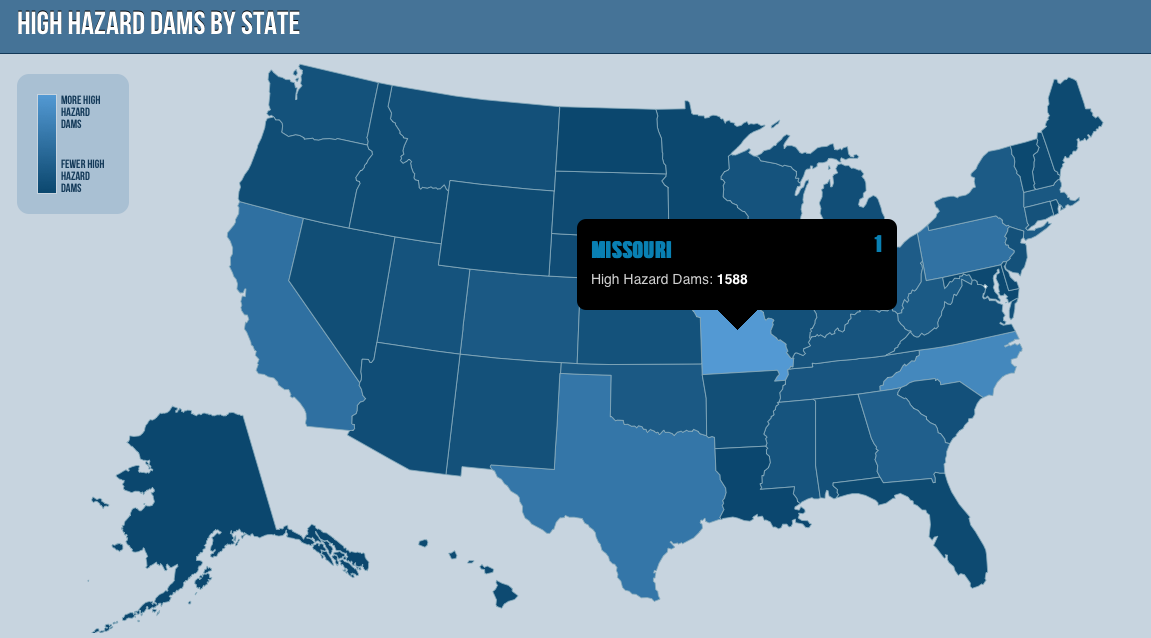AMERICAN SOCIETY OF CIVIL ENGINEERS
The average age of the 84,000 dams in the country is 52 years old. The nation’s dams are aging and the number of high-hazard dams is on the rise. Many of these dams were built as low-hazard dams protecting undeveloped agricultural land. However, with an increasing population and greater development below dams, the overall number of high-hazard dams continues to increase, to nearly 14,000 in 2012. The number of deficient dams is estimated at more than 4,000, which includes 2,000 deficient high-hazard dams. The Association of State Dam Safety Officials estimates that it will require an investment of $21 billion to repair these aging, yet critical, high-hazard dams.
Dams: Conditions & Capacity
Our nation’s dams provide essential benefits such as drinking water, irrigation, hydropower, flood control, and recreation. The safe operation and proper maintenance of these dams is critical to sustaining these benefits while preventing the possibility of a dam failure. Thousands of our nation’s dams are in need of rehabilitation to meet current design and safety standards. They are not only aging, but are subject to stricter criteria as a result of increased downstream development and advancing scientific knowledge predicting flooding, earthquakes, and dam failures.
Dams are classified based on their hazard potential, or anticipated consequences in the case of failure. The failure of a dam that is classified as high-hazard is anticipated to cause a loss of life. As of 2012, there are 13,991 dams in the United States that are classified as high-hazard, showing a continued increase in the overall number of dams with that classification. The number has increased from 10,118 high-hazard dams just ten years ago. Another 12,662 dams are currently labeled as significant hazard, meaning a failure would not necessarily cause a loss of life, but could result in significant economic losses.
The average age of our nation’s dams is 52 years. By 2020, 70% of the total dams in the United States will be over 50 years old. Fifty years ago dams were built with the best engineering and construction standards of the time. However, as the scientific and engineering data have improved, many dams are not expected to safely withstand current predictions regarding large floods and earthquakes. In addition, many of these dams were initially constructed using less-stringent design criteria for low-hazard dams due to the lack of development below the dam.
The U.S. Census Bureau estimates a population increase of 130 million people within the United States by 2050. This population growth will likely move development further into the unpopulated areas below aging dams, increasing the populations at risk and reclassifying many low or significant hazard dams as high-hazard. However, “high-hazard” does not necessarily mean the dam is deficient, but instead that the consequences are expected to include loss of life should the dam fail.
Dam failures can not only risk public safety, but they can cost our economy millions of dollars in damages. For example, the Iowa Lake Delhi dam failure in 2010 cost an estimated $50 million in damages and $120 million in economic losses, and swept away half a dozen homes. Since dam failures can cause severe consequences to public safety and the economy, emergency action plans (EAPs) for use in the event of an impending dam failure or other uncontrolled release of water remain vital. While the number of high-hazard dams with an EAP has increased, only 66% of dams have EAPs, far below the national goal of 100%.
The complexity of monitoring the conditions of our nation’s dams is partly because they are owned and operated by many different entities. While some of the nation’s dams are owned and operated by federal, state, and local governments, the majority, 69%, are owned by a private entity. The federal government owns 3,225 dams, or approximately 4% of the nation’s dams. It may be surprising to some that the U.S. Army Corps of Engineers owns only 694 dams.
Other than 2,600 dams regulated by the Federal Energy Regulatory Commission, the remaining dams in the nation are not regulated by the federal government, but instead rely on state dam safety programs for inspection. State dam safety programs have primary responsibility and permitting, inspection, and enforcement authority for 80% of the nation’s dams. Therefore, state dam safety programs bear a large responsibility for public safety, but unfortunately, many state programs lack sufficient resources, and in some cases enough regulatory authority, to be effective. In fact, the average number of dams per state safety inspector totals 207. In South Carolina, just one and a half dam safety inspectors are responsible for the 2,380 dams that are spread throughout the state. Alabama remains the only state without a dam safety regulatory program.
View Interactive map: High Hazard Dams by State
View Full Report (ASCE.org): Dams Grade: 2013 Report Card for America’s Infrastructure
About the American Society of Civil Engineers (ASCE)
www.asce.org
“Founded in 1852, the American Society of Civil Engineers (ASCE) represents more than 147,000 members of the civil engineering profession worldwide, and is America’s oldest national engineering society. ASCE’s vision is to position engineers as global leaders building a better quality of life…Comprised of Regional Councils, Younger Member Councils, Sections, Branches, Student Chapters and Clubs and International Student Groups, the Society and its volunteers are fully engaged in making this a better world by design.”
Tags: American Society of Civil Engineers, ASCE, Report Card for America's Infrastructure








 RSS Feed
RSS Feed